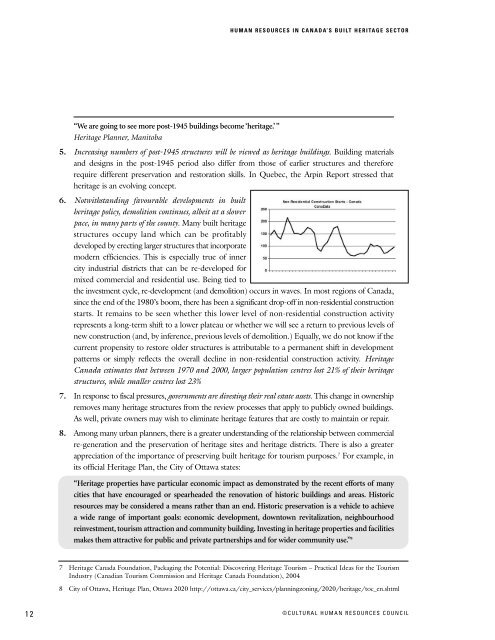Human Resources in Canada's Built Heritage Sector: Mapping the ...
Human Resources in Canada's Built Heritage Sector: Mapping the ...
Human Resources in Canada's Built Heritage Sector: Mapping the ...
- No tags were found...
You also want an ePaper? Increase the reach of your titles
YUMPU automatically turns print PDFs into web optimized ePapers that Google loves.
HUMAN RESOURCES IN CANADA’S BUILT HERITAGE SECTOR“We are go<strong>in</strong>g to see more post-1945 build<strong>in</strong>gs become ‘heritage.’ ”<strong>Heritage</strong> Planner, Manitoba5. Increas<strong>in</strong>g numbers of post-1945 structures will be viewed as heritage build<strong>in</strong>gs. Build<strong>in</strong>g materialsand designs <strong>in</strong> <strong>the</strong> post-1945 period also differ from those of earlier structures and <strong>the</strong>reforerequire different preservation and restoration skills. In Quebec, <strong>the</strong> Arp<strong>in</strong> Report stressed tha<strong>the</strong>ritage is an evolv<strong>in</strong>g concept.6. Notwithstand<strong>in</strong>g favourable developments <strong>in</strong> buil<strong>the</strong>ritage policy, demolition cont<strong>in</strong>ues, albeit at a slowerpace, <strong>in</strong> many parts of <strong>the</strong> county. Many built heritagestructures occupy land which can be profitablydeveloped by erect<strong>in</strong>g larger structures that <strong>in</strong>corporatemodern efficiencies. This is especially true of <strong>in</strong>nercity <strong>in</strong>dustrial districts that can be re-developed formixed commercial and residential use. Be<strong>in</strong>g tied to<strong>the</strong> <strong>in</strong>vestment cycle, re-development (and demolition) occurs <strong>in</strong> waves. In most regions of Canada,s<strong>in</strong>ce <strong>the</strong> end of <strong>the</strong> 1980’s boom, <strong>the</strong>re has been a significant drop-off <strong>in</strong> non-residential constructionstarts. It rema<strong>in</strong>s to be seen whe<strong>the</strong>r this lower level of non-residential construction activityrepresents a long-term shift to a lower plateau or whe<strong>the</strong>r we will see a return to previous levels ofnew construction (and, by <strong>in</strong>ference, previous levels of demolition.) Equally, we do not know if <strong>the</strong>current propensity to restore older structures is attributable to a permanent shift <strong>in</strong> developmentpatterns or simply reflects <strong>the</strong> overall decl<strong>in</strong>e <strong>in</strong> non-residential construction activity. <strong>Heritage</strong>Canada estimates that between 1970 and 2000, larger population centres lost 21% of <strong>the</strong>ir heritagestructures, while smaller centres lost 23%7. In response to fiscal pressures, governments are divest<strong>in</strong>g <strong>the</strong>ir real estate assets. This change <strong>in</strong> ownershipremoves many heritage structures from <strong>the</strong> review processes that apply to publicly owned build<strong>in</strong>gs.As well, private owners may wish to elim<strong>in</strong>ate heritage features that are costly to ma<strong>in</strong>ta<strong>in</strong> or repair.8. Among many urban planners, <strong>the</strong>re is a greater understand<strong>in</strong>g of <strong>the</strong> relationship between commercialre-generation and <strong>the</strong> preservation of heritage sites and heritage districts. There is also a greaterappreciation of <strong>the</strong> importance of preserv<strong>in</strong>g built heritage for tourism purposes. 7 For example, <strong>in</strong>its official <strong>Heritage</strong> Plan, <strong>the</strong> City of Ottawa states:“<strong>Heritage</strong> properties have particular economic impact as demonstrated by <strong>the</strong> recent efforts of manycities that have encouraged or spearheaded <strong>the</strong> renovation of historic build<strong>in</strong>gs and areas. Historicresources may be considered a means ra<strong>the</strong>r than an end. Historic preservation is a vehicle to achievea wide range of important goals: economic development, downtown revitalization, neighbourhoodre<strong>in</strong>vestment, tourism attraction and community build<strong>in</strong>g. Invest<strong>in</strong>g <strong>in</strong> heritage properties and facilitiesmakes <strong>the</strong>m attractive for public and private partnerships and for wider community use.” 87 <strong>Heritage</strong> Canada Foundation, Packag<strong>in</strong>g <strong>the</strong> Potential: Discover<strong>in</strong>g <strong>Heritage</strong> Tourism – Practical Ideas for <strong>the</strong> TourismIndustry (Canadian Tourism Commission and <strong>Heritage</strong> Canada Foundation), 20048 City of Ottawa, <strong>Heritage</strong> Plan, Ottawa 2020 http://ottawa.ca/city_services/plann<strong>in</strong>gzon<strong>in</strong>g/2020/heritage/toc_en.shtml12©CULTURAL HUMAN RESOURCES COUNCIL










